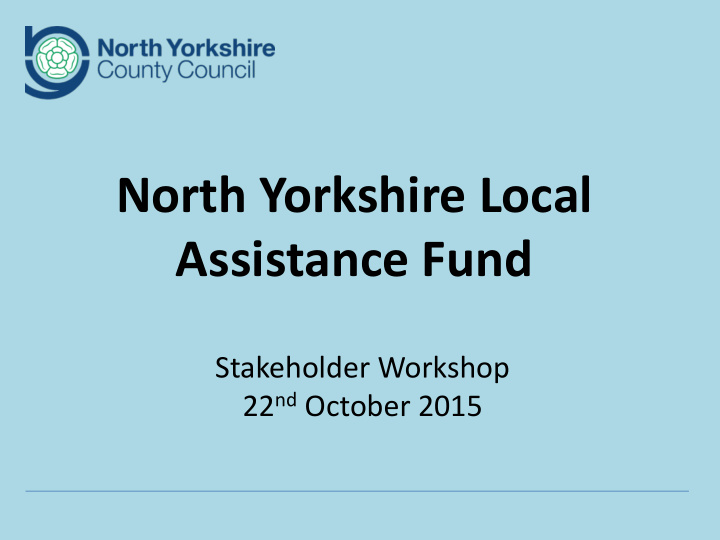



North Yorkshire Local Assistance Fund Stakeholder Workshop 22 nd October 2015
Welcome Neil Irving Assistant Director Policy and Partnerships, NYCC
Aims of the sessions • Share progress of the Fund (Sep 2014-Sep 2015). • Highlight changes implemented since the last workshop. • Introduction to Connect Assist. • Group discussion – discuss and document key points from agencies about their experiences since the last workshop and first feedback for Connect Assist.
Session One Fund overview Mark Taylor Policy and Partnerships, NYCC
What issues were raised What did we do as a at the last workshop? result? • • Some agencies noted they had At the last workshop we agreed that, where capacity issues arise, seen an increase in their the agency informs us and we will capacity, with more people work together to rectify the issue. going to the service leading to a We have also placed a greater greater amount of time taken emphasis on stream lining the on applications. online form. • Odd incidence of supporting • We sent out a bulletin agencies making inappropriate reminding partners of the referrals to authorised agencies. appropriate route for referrals.
Cont’d • • Heavy reliance on an online form We worked with Charis Grants to produce a paper copy of the online especially when access to the form. New form is downloadable and internet can be problematic. printable. • We have continued to update our • Uncertainty about who an ‘other forms of support’ leaflet applicant can go to if they aren’t available on our website – biggest eligible for a NYLAF application and addition of Darlington Credit South Yorkshire Credit Union isn’t accessible or cannot help in that Union. instance. • To include Co-op vouchers in the • We made numerous list of food vouchers to help more representations to the Co-op but rural areas. they did not want to participate.
Other developments over the past 12 months • The cessation of Central Government ring-fenced funding and NYCC’s continued commitment to the Fund. • The procurement of a new provider
Customers supported by the NYLAF • Year 1 (1 Apr 2013 – 31 Mar 2014) Applicants – 2,796 Applications – 3,799 • Year 2 (1 Apr 2014 – 31 Mar 2015) Applicants – 4,773 Applications – 5,130 • Year 3 (6 months - 1 Apr 2015 – 30 Sep 2015*) Applicants – 1,957 Applications – 2,087 *The final three days of September are projected as figures aren’t available yet
Applications by District 3000 2500 Year 1 Year 2 Year 3/ Projection 2000 1500 1000 500 0 Harrogate Scarborough (inc RC) Selby Richmondshire Craven Hambleton Ryedale
Items Awarded 3000 2500 Year 1 Year 2 Year 3/Projection 2000 1500 1000 500 0 White Goods Furniture Other Essential Home Repairs Utility Food Clothing
250 Awards by vulnerability Not including Rainbow Centre data Homeless/Risk of homelessness 200 Learning Disability Released from prison/Supervised on a community order Drug/Alcohol dependency Family under exceptional pressure Mental Health Problem Domestic Abuse Physical Disability 150 Carer 100 50 0 Sep-14 Oct-14 Nov-14 Dec-14 Jan-15 Feb-15 Mar-15 Apr-15 May-15 Jun-15 Jul-15 Aug-15 Sep-15*
Monthly spend Actual v monthly allocation 90000 80000 70000 60000 50000 40000 30000 20000 10000 0
Food Awards • Continue with PayPoint awards as it is. PayPoint voucher posted, emailed or texted over to applicant to exchange for cash to be used. Benefits of speed and possible instant transfer to applicant as well as provision could be used where access to a major supermarket not available. More risk associated with provision of cash. • Move to food vouchers. There would have to be an earlier cut-off time to post out vouchers which even then could not 100% guarantee a next day delivery. Increased control in that the voucher could only be redeemed in the store, although it can be used to buy anything in store. • A hybrid system of vouchers and PayPoint. All applications submitted before a set time are sent out through vouchers, after a set time it must be specified how the applicant wants to receive the award – voucher next day or same day email or text. • A model of greater control, where all food awards are sent to the agency and not the applicant. The agency can then determine what is done with the award and whether a greater level of control is needed, i.e. accompanying applicant to store or doing click and collect online. • Food parcels. The highest level of control, applicant can only receive food provided. Increased cost of parcels, potential food waste, complex parcel options, potentially longer delivery times than vouchers.
Advanced communication skills for telephone enquiry management Connect Assist October 2015
Organisations we work with Our contact centre Partners 15 www.ConnectAssist.co.uk
Connect Assist Multi channel Helpline provider. 16 www.ConnectAssist.co.uk
How has it gone Our aims Give strong customer service Have staff dedicated to you at all times : Linda Jones Julie-Ann Lewis Nicole Gilbert Lucy Mc Arthur Source as locally as possible and continue to develop the supplier network 17 www.ConnectAssist.co.uk
Usage September 28 th – October 20 th Applications to date 263 applications 102 Emergency requests broken down as follows 170 approved / Completed 57 awaiting approval 4 rejected 8 in draft Main requests white goods and beds £18,383.40p 18 www.ConnectAssist.co.uk
r Responsiveness Fulfilment targets 24 hours Emergencies 48 hours White goods 72 Hours gift cards Supplier network enhancements being explored. 19 D www.ConnectAssist.co.uk
Thank you for coming Contact: nylaf@northyorks.gov.uk Public site: www.northyorks.gov.uk/nylaf Agency site: www.nypartnerships.org.uk/nylaf
Recommend
More recommend